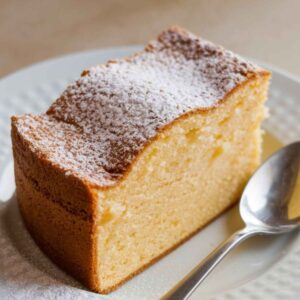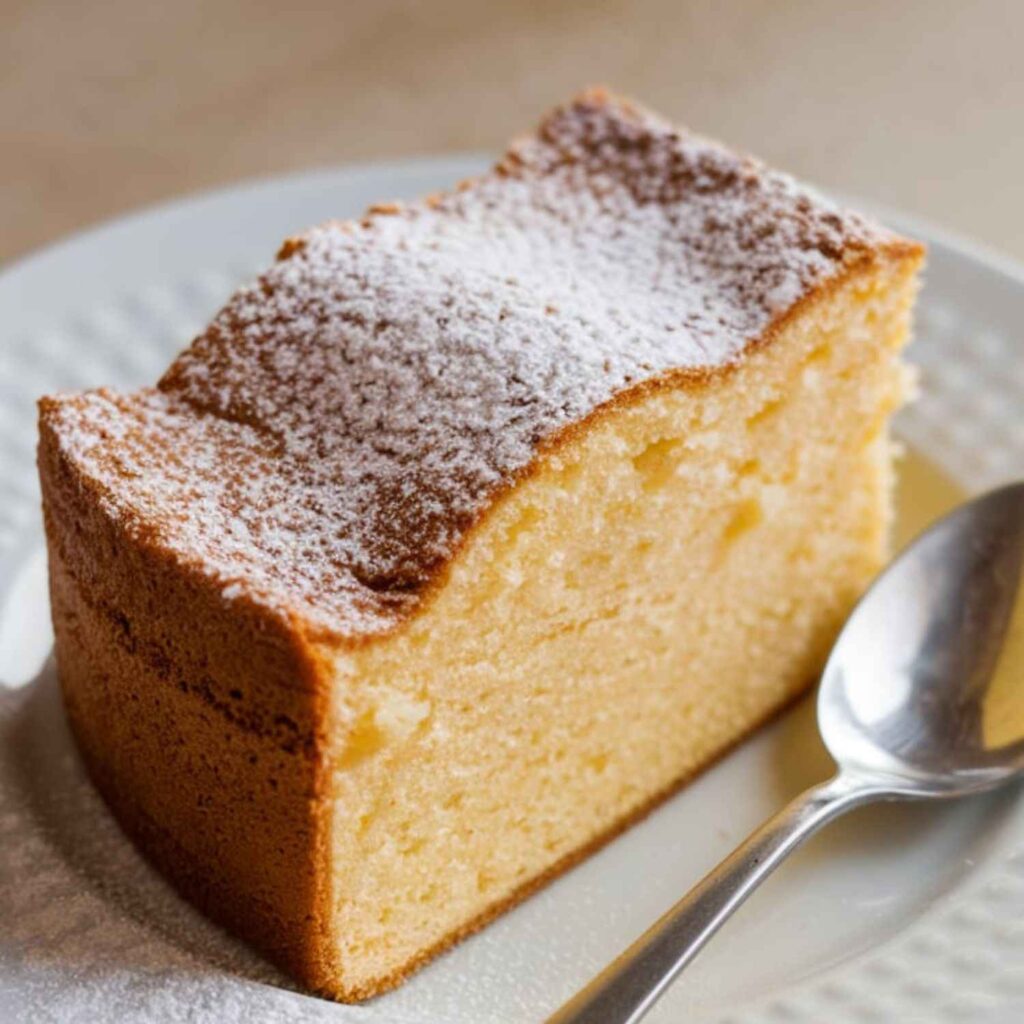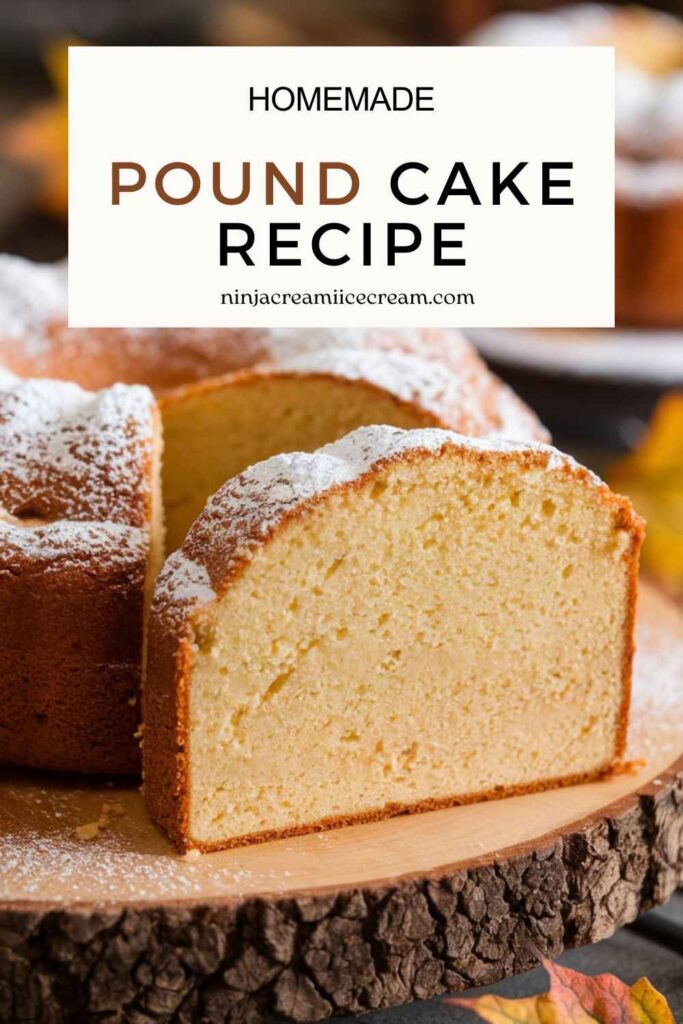Pound Cake is a classic dessert known for its rich, buttery flavor and dense, yet tender texture. Traditionally, the recipe consists of just four basic ingredients—flour, butter, sugar, and eggs—one pound of each, hence the name “pound cake.” This simple ratio created a cake that was easy to prepare and a staple in many households. Over time, the recipe has evolved, with variations that include flavorings like vanilla, citrus, or almond, but it has always maintained its signature rich and moist qualities.
Disclosure: This post may contain affiliate links. As an Amazon Associate, I earn from qualifying purchases. Read more.
The history of Pound Cake dates back to the 18th century in Europe, where it was often made in large quantities for gatherings. Its simplicity made it an ideal cake for both beginner bakers and those looking for a straightforward, no-fuss treat. As it became popular in America, different regional takes emerged, but the essence of the cake remained the same: a moist, flavorful dessert that is easy to make and perfect for any occasion.
Pound Cake Recipe
Ingredients for Pound Cake Recipe
- Butter
- Amount: 1 cup (2 sticks)
- Description: Butter is the key ingredient that gives pound cake its signature richness and moistness. Using unsalted butter ensures that you can control the amount of salt in your recipe. Make sure the butter is softened to room temperature to achieve a smooth, creamy batter.
- Sugar
- Amount: 1 cup
- Description: Granulated sugar provides the sweetness and helps with the structure of the cake. It works with the butter to create a light and airy texture when beaten together.
- Eggs
- Amount: 4 large eggs
- Description: Eggs play a crucial role in binding the ingredients and adding moisture. They also contribute to the cake’s rich texture and help the batter rise during baking. Be sure to use room-temperature eggs to ensure a smooth batter.
- All-Purpose Flour
- Amount: 2 cups
- Description: All-purpose flour forms the base of the cake and provides the structure needed for the pound cake. It is important to measure the flour correctly to avoid making the cake dense. For a lighter texture, you can sift the flour before adding it to the mixture.
- Baking Powder (Optional)
- Amount: 1 teaspoon
- Description: While traditional pound cake recipes do not call for baking powder, adding a teaspoon can help create a lighter, fluffier texture. If you prefer a denser cake, you can omit this ingredient.
- Salt
- Amount: 1/4 teaspoon
- Description: Salt enhances the flavor of the cake and balances the sweetness. A small amount goes a long way in elevating the overall taste.
- Milk or Cream (Optional)
- Amount: 1/4 cup
- Description: Adding milk or cream increases the richness of the pound cake. While optional, it can make the cake slightly moister and add a creamier texture. If you prefer a lighter version, you can use whole milk or skip this ingredient.
- Vanilla Extract (Optional)
- Amount: 1 teaspoon
- Description: Vanilla extract is a common addition that brings warmth and depth to the flavor of the pound cake. You can substitute it with almond extract or citrus zest for different flavor profiles.
- Citrus Zest (Optional)
- Amount: 1 tablespoon
- Description: Adding lemon, orange, or lime zest can give your pound cake a fresh, vibrant flavor. This optional ingredient is perfect if you want to add a light, zesty twist to the traditional pound cake recipe.
These simple yet essential ingredients come together to create a dense, moist, and flavorful pound cake. Depending on your taste and preferences, you can add variations like chocolate chips, fruit, or nuts, but this classic combination will always provide a delicious, versatile base.
Instructions for Making Pound Cake
-
Preheat the Oven
- Preheat your oven to 350°F (175°C).
- Grease a 9×5-inch loaf pan or a 10-inch bundt pan with butter or cooking spray, then lightly flour the pan, tapping out any excess flour. This will ensure that the cake comes out easily once baked.
-
Prepare the Dry Ingredients
- In a medium bowl, sift the flour and salt together to remove any lumps and ensure the ingredients are evenly distributed. If you’re using baking powder, sift that in as well. Set this bowl aside.
-
Cream the Butter and Sugar
- In a large mixing bowl, beat the softened butter with an electric mixer or stand mixer on medium speed until it becomes light and fluffy. This should take about 3-4 minutes. The butter should look pale and have a smooth texture.
- Gradually add the granulated sugar while continuing to beat. Scrape down the sides of the bowl as needed. Keep beating until the mixture is well-combined and fluffy, which should take another 2-3 minutes.
-
Add the Eggs
- One at a time, add the eggs to the butter-sugar mixture, beating well after each addition. This helps the eggs incorporate evenly and prevents the batter from curdling.
- After all the eggs are added, beat the mixture for an additional minute to ensure it’s smooth and airy.
-
Add the Dry Ingredients
- Lower the mixer speed to low and gradually add the sifted dry ingredients (flour, salt, and baking powder if using) to the butter mixture, alternating with milk or cream (if using). Start with the dry ingredients and end with the milk.
- Mix until just combined. Be careful not to overmix, as this can result in a dense cake. The batter should be thick and smooth.
-
Add Flavoring (Optional)
- If you’re adding vanilla extract or citrus zest, stir it into the batter after the dry ingredients have been incorporated. Use a rubber spatula to fold the ingredients in gently.
-
Transfer the Batter to the Pan
- Scrape the batter into the prepared baking pan, smoothing the top with a spatula. Make sure the batter is evenly distributed in the pan.
-
Bake the Pound Cake
- Place the pan in the preheated oven and bake for about 60-70 minutes. The cake should be golden brown and a toothpick inserted into the center should come out clean or with just a few moist crumbs.
- If the cake starts to brown too quickly, you can cover it loosely with aluminum foil during the last 20 minutes of baking.
-
Cool the Cake
- Once the cake is done, remove it from the oven and let it cool in the pan for 10-15 minutes. This allows it to firm up a bit, making it easier to remove from the pan.
- After it cools slightly, turn the cake out onto a wire rack to cool completely.
-
Serve and Enjoy
- Once completely cooled, you can serve the pound cake as is, or drizzle with a simple glaze, dust it with powdered sugar, or top it with whipped cream or fresh fruit for added flavor and decoration.
- Slice the cake into generous portions and enjoy the moist, buttery goodness of your homemade pound cake!

Pound Cake Recipe
Equipment
- Electric Mixer or Stand Mixer
- Mixing Bowls:
- Measuring Cups and Spoons:
- Sifter or Fine Mesh Strainer:
- Rubber Spatula
- Loaf Pan or Bundt Pan
- Wire Rack
- Toothpick or Cake Tester –
Ingredients
- 1 cup Butter (2 sticks), softened
- 1 cup Granulated Sugar
- 4 large Eggs, at room temperature
- 1½ cups All-Purpose Flour
- 1 tsp Baking Powder (optional, if you want a lighter texture)
- ¼ tsp Salt
- ¼ cup Milk or Cream (optional, for a richer texture)
- 1 tsp Vanilla Extract (optional, for flavor)
- 1 tbsp Citrus Zest (optional) (lemon or orange zest for added flavor)
Instructions
- Preheat the Oven and Prepare the PanPreheat your oven to 350°F (175°C). Grease and flour a 9x5-inch loaf pan or a 10-inch bundt pan.
- Cream Butter and SugarIn a large bowl, beat the softened butter and granulated sugar together until light and fluffy, about 3-4 minutes.
- Add Eggs and MixAdd the eggs one at a time, beating well after each addition. Mix until smooth.
- Incorporate Dry IngredientsIn a separate bowl, sift together the flour, salt, and baking powder (if using). Gradually add the dry ingredients to the butter mixture, alternating with the milk or cream. Mix until just combined.
- Bake the CakePour the batter into the prepared pan and bake for 60-70 minutes, or until a toothpick inserted in the center comes out clean. Cool in the pan for 10-15 minutes, then transfer to a wire rack to cool completely. Enjoy!
Notes
-
Room Temperature Ingredients
Ensure that the butter and eggs are at room temperature before starting. This helps create a smooth, well-incorporated batter and prevents the cake from becoming dense or uneven. -
Accurate Measurements
Measure ingredients carefully, especially flour. Too much flour can make the cake dry, while too little can affect the structure. For best results, use a kitchen scale for flour measurements. -
Mixing the Batter
When combining the wet and dry ingredients, avoid overmixing. Overmixing can lead to a tough texture due to the development of gluten. Mix until just combined. -
Pan Size and Type
The size of the pan can impact baking time. If using a different pan size, adjust the baking time accordingly. A 9x5-inch loaf pan or a 10-inch bundt pan is ideal for this recipe. -
Baking Time Variations
Every oven is different, so start checking the cake around 55 minutes. If the top is browning too quickly, cover it with foil to prevent over-browning while the inside cooks. -
Cooling the Cake
Let the cake cool in the pan for at least 10-15 minutes before transferring it to a wire rack. This allows the cake to set and makes it easier to remove from the pan without breaking. -
Customizing the Flavor
Feel free to experiment with flavors such as citrus zest (lemon, orange) or extracts like almond or vanilla. These additions can elevate the flavor and make the cake uniquely yours. -
Storage
Pound Cake can be stored at room temperature in an airtight container for up to 3 days. For longer storage, slice and freeze the cake for up to 3 months. -
Toppings
While delicious on its own, Pound Cake can be enhanced with various toppings, such as whipped cream, fresh berries, or a simple glaze, to suit your preferences.
Tips for the Perfect Pound Cake
- Use Room Temperature Ingredients
- Make sure both the butter and eggs are at room temperature. Cold butter and eggs can cause the batter to curdle, resulting in a dense, uneven texture. Let them sit out for about 30 minutes before starting.
- Don’t Overmix the Batter
- Once you add the dry ingredients, mix just until everything is combined. Overmixing the batter can lead to a tough, dense cake due to the development of gluten in the flour.
- Cream the Butter and Sugar Properly
- Beating the butter and sugar together until light and fluffy is key to achieving a light and airy cake. Make sure to cream them for 3-4 minutes to fully incorporate air into the batter.
- Measure Your Ingredients Accurately
- For the best results, measure your ingredients correctly. Too much flour can make the cake dry, while too little can lead to a collapsed structure. Use a kitchen scale for the most accurate measurements, especially for flour.
- Choose the Right Pan
- Use a 9×5-inch loaf pan or a 10-inch bundt pan for best results. If using a different size, keep an eye on the baking time, as it might need adjustment depending on the pan size.
- Check for Doneness Early
- Start checking your cake around 55 minutes of baking. The top should be golden brown, and a toothpick inserted into the center should come out clean or with just a few moist crumbs. If the cake is browning too quickly, cover it with aluminum foil.
- Cool the Cake Correctly
- Allow the cake to cool in the pan for about 10-15 minutes before transferring it to a wire rack. This helps the cake firm up slightly, making it easier to remove from the pan without breaking.
- Customize Flavors
- Add your favorite extracts, such as vanilla, almond, or lemon, to give the cake a unique twist. Citrus zest (like lemon or orange) also adds a fresh, zesty flavor to balance the richness.
- Don’t Skip the Flouring Step
- After greasing the pan, dust it lightly with flour to prevent the cake from sticking. This step is especially important if you’re using a bundt pan with intricate designs.
- Serve with a Topping or Glaze
- While pound cake is delicious on its own, you can elevate it by adding a glaze, whipped cream, or fresh fruit. A simple lemon glaze or a drizzle of chocolate ganache pairs wonderfully with this cake.
- Storage and Freezing
- Store leftover pound cake in an airtight container at room temperature for up to 3 days. If you want to keep it longer, slice and freeze individual portions wrapped in plastic wrap for up to 3 months.
By following these tips, you’ll be well on your way to making a perfect pound cake every time!
Conclusion
Pound Cake is a timeless, classic dessert that never goes out of style. With its simple yet rich ingredients, it offers a delicious balance of buttery flavor and dense, moist texture. The beauty of this recipe lies in its versatility—whether served plain or topped with fresh fruit, whipped cream, or a drizzle of glaze, Pound Cake adapts to any occasion. Its ease of preparation and satisfying results make it a favorite among both beginner bakers and seasoned pros.
This recipe, rooted in tradition, is a great starting point for anyone looking to create a delicious homemade treat. While it’s delicious on its own, you can easily make it your own by experimenting with various flavorings like citrus zest, vanilla, or almond extract. Adding a touch of creativity with fruit or nut toppings can take this cake to the next level, making it the perfect dessert for gatherings, holidays, or a simple afternoon snack.
Whether you’re baking for a special occasion or just craving a comforting homemade cake, Pound Cake is a recipe you can rely on. It offers a simple, rewarding baking experience, with results that will impress anyone who takes a bite. So, gather your ingredients and enjoy the process of making this beloved cake that has stood the test of time and continues to bring joy to dessert tables everywhere.

Hi, I’m Katelyn Williams, the expert behind Ninjacreamiicecream.com. With a deep passion for creating delectable ice cream recipes, I’m here to share my love for all things ice cream. I earned my Bachelor’s degree from Louisiana State University, and since then, I’ve been dedicated to perfecting the art of ice cream making. From classic flavors to innovative creations, my goal is to inspire you to make delicious and creamy treats at home effortlessly. Join me for the best recipes, tips, and techniques to elevate your ice cream game and indulge in delightful frozen desserts!


